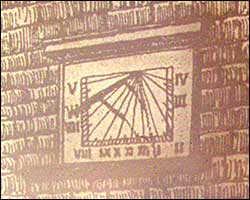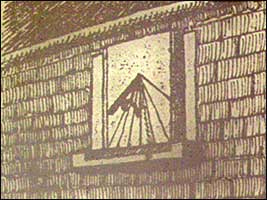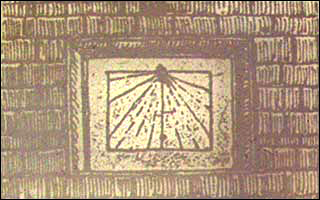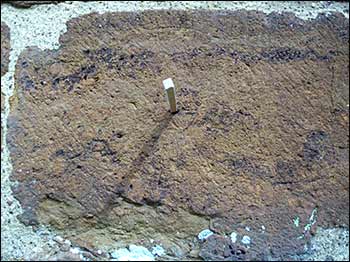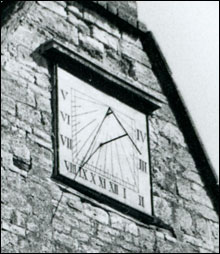|
||||||||||||
| The Rushden Echo and Argus, 17th August 1900, transcribed by Gill Hollis |
||||||||||||
|
The Time O’Day
|
||||||||||||
|
How Higham and Rushden People Used To Judge It
By The Amateur Antiquary |
||||||||||||
|
A few centuries ago, when the Borough of Higham Ferrers was an educational and business centre of great importance and the College was in full working order, when Rushden was a pastoral village, and boot and shoe manufacture as a staple industry was unknown in the district, the great question of questions was, as now, “how goes the enemy?” I don’t know how it is that people have always described Old Father Time as an enemy. Surely there never was a more soul-stirring sound than the musical tones of the church clock at 6 p.m. Present-day workers in factories where the thermometer indicates 90 degrees of heat have reason to bless the sound, but it is none the less a fact that Old Time has never been regarded as a friend. Perhaps it is because he can never be circumvented or cheated. However this may be, it has always been considered of the utmost importance to keep one’s-self informed of his movements.
Now-a-days we are exceptionally well situated in this respect. We have all sorts of contrivances for getting at the time o’ day – from the youth’s knock about repeater at 2/9 to the costly chronometer and the turret clock. Then, at 10 o’clock every morning, if the officials at Greenwich are up in time and haven’t been making a night of it, we have the correct time flashed all over the United Kingdom or at least those portions of it where there are post-offices – providing the postmaster happens to be at home. Even before we had these great advantages, there were the old verge watches or “turnips,” which could be more or less depended on – generally less, in spite of what the owners might say. But if we hark back to the days before the advent of the “turnips,” what do we find? We find that the only method our misguided ancestors had of finding out the time to stop work was by looking at a sundial. This, on the face of it, seems some-what awkward for those who happened to be at work a mile or two from home, because sundials, weighing as they generally do, several hundredweight, are not exactly portable affairs. As a matter of fact, though, under such circumstances, our forefathers didn’t bother about the sundials at all; they just came home when they were ready. If, when they got home, the dial said it was about six o’clock they flattered themselves they possessed excellent judgement, and if they found it was not quite six they were all the better pleased.
Sundials had many advantages. For instance, there was no such thing as having to send them to the watchmaker’s to be cleaned, and finding out they required a new mainspring or new case and works. Then dials were, as a rule, safe from mischievous children. There was no such thing as picking out the hairspring with a pin – a most delightful sensation to the juvenile mind – because there was no hairspring. There was one disadvantage which should be mentioned here and that was that dials had to be fixed to some house or church which faced to the south or somewhere thereabouts. If you didn’t fix the things on the south side of the building you, either had to get up before it was light and go to bed about dinner time, or walk a long way to see someone else’s dial, or else say you didn’t care a button what time it was. It was therefore necessary to build the house to suit the dial, which was not always convenient. Now-a-days we should easily get over the difficulty by fixing the dial on a swivel, so that we could turn it to what time we liked, which would be a splendid arrangement for getting up in the morning by, but this method does not seem to have occurred to our forefathers. I am aware that it may be objected that we could not tell the correct time that way, but school children and railway companies will bear me out when I say that would not be an unmixed evil. I have been round Higham and Rushden to see how many dials we can muster in the two towns and find that the total is two and a half – two in Rushden and half a one in Higham. There may be others but if there are I can’t find them. There are others in the surrounding district, but the weather has been too hot for extended journeys. The best-preserved dial I found is affixed to an old house at “the top end” of Rushden – the last house on the right hand side of the road as one goes towards Bedford, or pretends to go towards it. The house bears no date, and the dial has apparently been restored some time in the remote past. What its age is, I cannot tell. Perhaps some very, very old inhabitant might be able to tell us if he were inclined that way, but I question whether it would be wise to ask him, because he might happen to know too much. At any rate, we ought to be safe in saying that it was faithfully indicating the passage of time when the Rushden Brook, the delightfully odoriferous brook, was a babbling streamlet, sparkling like crystal. Those days are long since past, and the brook – phew! Take it away. I am getting away from my subject. Readers will kindly notice that the figures XII are not in the middle of the dial, which shows that the house does not face due south. This dial must, therefore, have been fixed up on the skew, by a man with a twisted eye. Some may not be able to see how I arrive at this conclusion, but that is a matter on which I am sworn to secrecy. The other Rushden dial is affixed to the stables at “The Cottage,” and looks capable of many more years’ work with care. I say with care, because unless care is exercised that dial, which can just be seen from the street now, will soon be covered in by a tree which luxuriates just in front of it. In that case it will, of course, be useless as a time indicator, and will only serve as a perch for sparrows.
The only dial or remains of a dial I could find at Higham is affixed to the south front of the grand old church, beneath the belfry window. The gnomon, which is the arrangement sticking out of the front to cast the shadow, has long been missing and Old Father Time has effaced the figures and made sad work with the lines on the face, which are somewhat fainter than they appear in the sketch. Still, there the dial is, for better or worse, and if it isn’t complete it is not my fault. Just above the dial is a hole, loosely filled up with stone. What that hole was for I shall have to leave to the imagination of my readers, for it completely staggers my intellect. After meditating on the subject for hours, it struck me that it might have served for the purpose of setting the hands and I was just going to write it down as a fact when I remembered that dials have no hands. Sooner than think any more about it, I would have that hole filled up permanently at my own expense. Besides, it doesn’t matter a bit, because there is a good clock on the west front.
|
||||||||||||
|
|
||||||||||||
|
|
||||||||||||
